Content
The amber bunches of Valentine grapes are so huge and beautiful that they fascinate any gardener. The culture is famous for its high yield and good marketability. Many lovers and owners of professional vineyards are looking for a description of the variety, photos, reviews, videos about Valentine grapes, in the hope of growing a handsome man on their site.
Description of the variety
Valentine is considered a table grape. The average ripening time coincides with the well-known Pervozvanny varieties, as well as Gift to Zaporizhzhia... The culture is famous for its huge beautiful bunches with delicious berries, from which excellent juice and wine is obtained.
Considering the description of the grape variety Valentine, photos, reviews, you should pay attention to the vine. Vigorous bushes with intensively growing shoots. With good feeding, the vine stretches long and requires free space.
The Valentine variety is famous for its large cylindrical bunches with an elongated lower part. The berries are loosely picked. The length of a large bunch can reach 40 cm, and the weight is 1.5 kg. One berry weighs about 16 g. Fruit length - 44 mm, width - 26 mm. The shape of the berry is cylindrical, elongated, slightly curved.
After ripening, the bunch of grapes of the Valentine variety becomes yellow with an amber tint. A distinctive feature is caulkiness. On the peel of ripe berries, dots appear that resemble freckles. From the sun, the side of the fruit is colored with a light brown tan. Ripening of bunches is amicable. The berries are not peas.
The pulp is of particular taste. The grape is so tender that it just melts in your mouth without feeling a thin skin. The pulp contains one or two seeds. When eaten, it tastes like sage-flavored nutmeg. The sugar content in ripe fruits is up to 19%, and the acid content is about 6 g / l.
By origin, the Valentine grape is a complex hybrid. The creators are breeders from Novocherkassk. The variety was obtained by crossing Muscat Summer with a hybrid derived from two popular grapes, Vostorg and Arcadia. The resulting Valentina variety has taken root in many regions, but requires shelter for good wintering.
The value of the Valentine variety lies in the stable harvest. The first bunches may appear in the second year of life, but growers usually remove them to form a bush. Ripening of bunches begins 140 days after the awakening of the buds. If the first bunches are removed in the second year, then the harvest of the next season will double. During the summer, ¾ of the length of the vine manages to ripen. During the autumn pruning of bushes, shoots with 8-12 buds are left.
Variety Valentine throws out bisexual flowers. The self-pollination ability allows you to get a crop without the participation of insects. A vine of the Valentina variety can withstand winter frosts down to -22aboutC. This is an extreme indicator at which the freezing of fruit buds has already begun. In order not to risk the future harvest, the vine is insulated in the fall. The process involves more than just covering the bush. First, a weak and not lignified vine is cut off, a bush is formed, and abundantly poured with water under the root. The soil around the trunk is covered with a thick layer of mulch. After these procedures, the vine is tied with a rope, wrapped in dense material, laid in a groove and sprinkled with soil.
Positive and negative traits of the variety
The following advantages will help to better describe the Valentine grape variety:
- stable fruiting and high yield rates;
- the Valentina variety is rarely affected by mildew, gray rot and is moderately resistant to powdery mildew;
- plucked bunches retain their presentation for a long time, can be stored and transported;
Among the shortcomings, the weak frost resistance of the Valentine variety is distinguished. Juicy large berries burst with excess moisture, and the sweet juice quickly attracts insects. The brown tanned skin of berries with freckles does not always attract buyers.
The video provides detailed characteristics of the Valentine grape variety:
Planting rules for seedlings
According to reviews and descriptions, Valentine grapes have a good survival rate of seedlings. Culture can be grown not only by a professional, but also by a novice amateur gardener. Planting grape seedlings is carried out according to the following rules:
- Sprawling, vigorous bushes require a lot of space. The optimal scheme for planting grape seedlings of the Valentine variety is 4x6 m.
- The variety loves light black soil, nutritious soil, organic fertilizing. This is a prerequisite for obtaining large bunches of grapes.
- You can plant seedlings in spring and autumn. Gardeners assure of the best survival rate during the October planting.
- A hole for a Valentine grape seedling is dug 80 cm deep and 40–60 cm in diameter. At the bottom, a drainage layer of small stone is required. At least three buckets of a mixture of black soil with humus are poured into the pit. Sand is added for looseness. After filling, the depth of the hole is about 50 cm.
- A new mound-shaped hole is formed from the fertile mixture. A seedling is placed on the top with roots, tilted slightly and sprinkled with gently loose soil.
- The planted grape seedling is watered with two buckets of water. For better engraftment, a root growth stimulator is added.
After absorbing water, the earth inside the hole will sag. The disadvantage is compensated for by adding soil and mulching with sawdust or peat. A peg is driven in near the hole. The grape seedling is tied, leaving in this state until rooting.
Propagation by cuttings
To start Valentine grapes on your site, you do not have to buy a seedling. The variety reproduces well by cuttings, and you can cut them in the fall from a bush from a familiar gardener or neighbor. To grow grapes, you must perform the following steps:
- The harvesting of grape cuttings of the Valentine variety is done during the autumn pruning. A ripe annual vine without damage to the bark and kidneys is suitable for reproduction.
- Cuttings are cut so long that they have at least two developed buds.
- Cut twigs of grapes are wrapped in a damp cloth. Store cuttings in the refrigerator or cellar, periodically moistening from a sprayer.
- In the end of December Grape cuttings Valentine is examined, the dried branches are discarded, and then disinfected. The planting material is dipped in a pink manganese solution and then washed with running water.
- For each cutting, an oblique cut is made above the lower bud with a pruner. Notches 1–2 cm long are cut along the bark with the edge of a knife to simplify the appearance of roots. Valentine grape cuttings are placed for a couple of days in a jar of water, where a growth stimulant is dissolved.
- Each gardener has his own way of sprouting roots. You can wrap the lower part of the cutting with moss or a damp cloth, film on top and put it in a warm place. Sometimes gardeners prefer to immediately plant the planting material in cups with a wet substrate, where root growth and simultaneous engraftment take place.
- If grape cuttings are wrapped in moss or a damp cloth, after bud break, they are seated in glasses with a nutrient substrate.
Germination of grape cuttings takes place on the windowsill. With the establishment of round-the-clock heat, ready-made seedlings are planted in a permanent place.
Plant care
Care for the grapes of the Valentine variety is needed, but the events do not provide for particularly complex actions. The standard procedure contains the following requirements:
- During the entire growing season, Valentine grapes need organic and mineral fertilizing. Watering is required, but during the ripening of berries with water, you cannot overdo it. Cracking of the fruit will begin.
- After each watering, the soil around the bush is loosened and covered with sawdust or peat mulch. Be sure to do additional weeding with abundant growth weeds.
- The vines of Valentine's grapes are subjected to medium and short pruning.
- In the fall, after pruning, the bushes are covered. Residents of the southern regions, where the thermometer does not fall below the critical minimum, can ignore the process.
From early spring to the moment of shelter for the winter, the vines of the Valentine variety are sprayed with preventive drugs.
Disease and pest control
The average resistance of Valentine grapes to powdery mildew increases the risk of damage to the bushes during the epidemic. The disease manifests itself on the leaves with light spots. The disease quickly spreads to the stems and berries. Mold, rot appears, accompanied by an unpleasant odor.
In order not to lose the entire harvest, the grape bush is urgently treated with a solution of colloidal sulfur or other preparations for powdery mildew. However, it is best to prevent the occurrence of disease by performing preventive spraying three times a year. In the fall, after the foliage has fallen off, the vine is treated with Bordeaux liquid or a solution of copper sulfate.
Preventive measures are timely pruning to prevent thickening. The exfoliated bark is removed from the old vine, since many parasites live on it. When the disease spreads, the affected hands and foliage are removed.
Valentines grapes have a lot of pests: leafworm, mites, phylloxera, itch. Store-bought preparations help to fight insects. The treatment of the bush is carried out according to the instructions on each package. For wasps, they hang traps from plastic bottles, into which a little sweet liquid is poured.
Testimonials
Gardeners leave the best reviews on Valentine's grape forums. It is rare to find dissatisfaction with the variety.
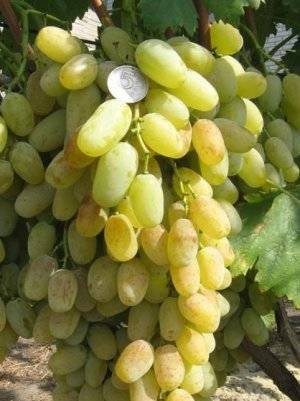
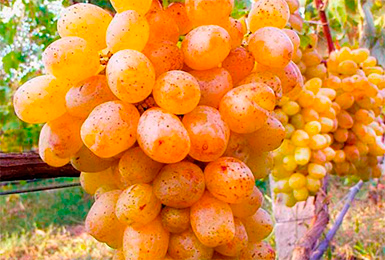
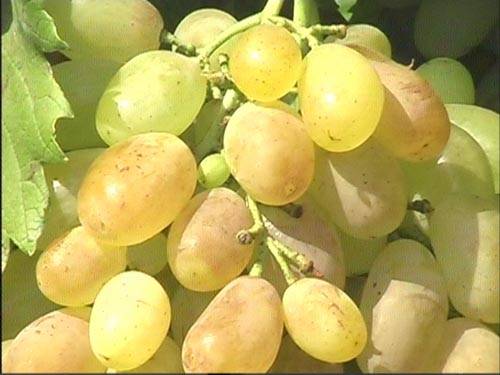
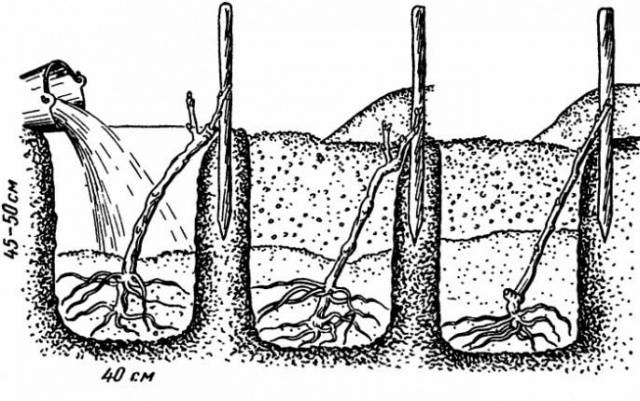

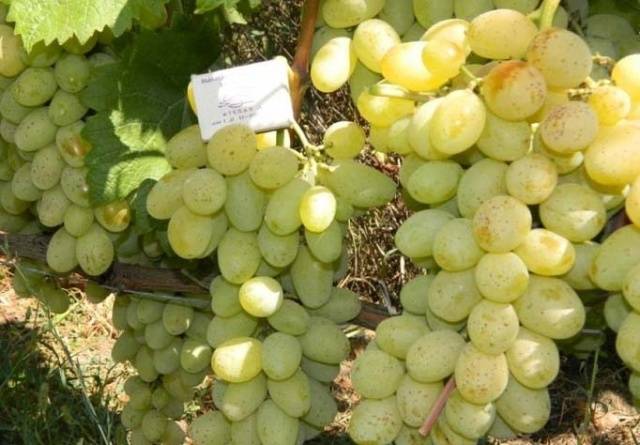










Valentina has been growing for the second year in my grapes, I bought "seeds" in the store, so far I have not seen a single bunch. This year, for the winter, I wrapped it with agrospan in two layers. the roots remained open. We'll have to cover the roots with humus or birch leaves. I did not know. that she can freeze, because. I am new to grape business. Thanks everyone for the advice.